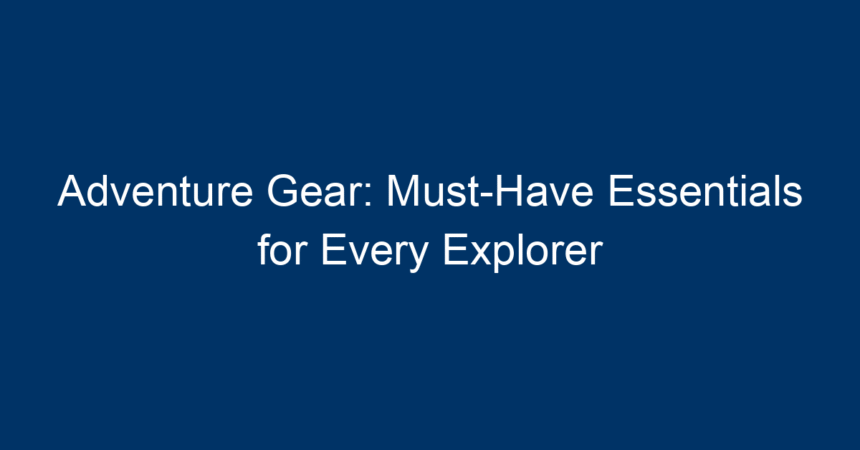Introduction
Embarking on an adventure, whether hiking through dense forests, scaling mountain peaks, or exploring hidden valleys, requires more than just enthusiasm. Having the right adventure gear can make all the difference between a memorable experience and a challenging ordeal. This guide explores essential gear that every explorer should consider packing. From clothing to gadgets, we will cover a range of items that ensure not only safety but also enjoyment during your escapades.
Why Is Adventure Gear Important?
The right gear protects you from the elements, enhances your performance, and makes your journey more comfortable. Investing in quality adventure gear is crucial for any explorer looking to make the most of their experience while minimizing risks.
1. Clothing: Layering for Comfort and Protection
Base Layers
The foundation of your adventure gear is a good set of base layers. Opt for moisture-wicking materials that will keep you dry. Fabrics like merino wool or synthetic blends are great choices. These materials pull sweat away from your skin, preventing chills during colder temperatures.
Insulation Layers
Next, you’ll want insulation layers to retain body heat. Fleece jackets and down vests are popular options. They’re lightweight, yet they provide excellent warmth without adding bulk.
Outer Layers
Lastly, an effective outer layer is key for protection against wind, rain, and snow. Look for waterproof and breathable jackets that will keep you dry while allowing sweat to escape. Consider investing in a quality rain pant as well.
Footwear
Proper footwear can make or break your adventure. Hiking boots should have good traction, be lightweight, and offer ankle support. Make sure to break them in before your trip to avoid blisters.
2. Navigation Tools: Finding Your Way
Maps and Compasses
Even though smartphones offer GPS services, traditional maps and compasses are reliable and never run out of battery. Carry a topographical map of the area you’ll be exploring and a compass for reliable navigation.
GPS Devices
If you prefer modern tools, a handheld GPS device can help you track your route. Look for devices with long battery life and preloaded maps to enhance your navigation.
Smartphone Applications
Consider downloading offline maps and navigation apps such as AllTrails or Gaia GPS. These apps not only provide trail information but also allow you to mark points of interest along your journey.
3. Safety Equipment: Be Prepared for Anything
First Aid Kit
Every adventurer should carry a well-stocked first aid kit. Essential items include band-aids, antiseptic wipes, pain relievers, and any personal medications. Familiarize yourself with how to use each item, especially in remote situations.
Emergency Whistle
An emergency whistle is compact and can be a lifesaver. It can help you signal for help without using up valuable energy shouting.
Multi-tool or Knife
Multi-tools are versatile and can assist with various tasks such as food preparation, gear repairs, and even first aid. A good knife is an essential tool that can come in handy in unexpected situations.
Headlamp or Flashlight
A headlamp allows for hands-free movement, making it ideal for camping or navigating in low light. Look for a model with adjustable brightness and a long battery life.
4. Hydration: Stay Hydrated, Stay Energized
Water Bottles
You must hydrate before, during, and after your adventure. Carry a durable water bottle that fits in your backpack’s side pocket for easy access. Look for insulated options to keep your liquids cool on hot days.
Water Purification System
In areas where fresh water sources are available, a portable water purification system is essential. Options include UV purifiers, filters, and purification tablets. Be sure to choose a method that suits your destination.
5. Cooking Gear: Fuel for Your Adventure
Portable Stove
Imagine enjoying a warm meal while watching the sunset from a mountaintop. A lightweight portable stove can allow you to cook meals whenever you need fuel.
Cooking Utensils
A compact cooking kit with a pot, spatula, and a lightweight camping stove will enable you to prepare simple meals on the go. Consider items made of titanium or aluminum for durability and efficiency.
Food Supplies
Pack high-energy foods like trail mix, energy bars, and dehydrated meals that are easy to cook and carry. They will keep your energy levels up during long hikes.
6. Shelter and Sleep: Rest Well for Better Adventures
Tent
A lightweight, weather-resistant tent is crucial for multi-day hikes or camping trips. Look for a model that’s easy to set up and take down. Check its weight, especially if you’ll be carrying it in your backpack.
Sleeping Bag
A cozy sleeping bag appropriate for the season will help ensure a good night’s sleep. Choose between down and synthetic materials depending on your preference and weather conditions.
Sleeping Pad
A sleeping pad provides insulation and comfort while sleeping on the ground. Consider models that pack down small and have good R-values for heat retention.
Conclusion: Get Out There and Explore!
Having the right adventure gear not only enhances your experience but also keeps you safe and comfortable in the wild. Whether you’re an experienced explorer or a novice adventurer, investing in quality clothing, navigation tools, safety equipment, hydration, cooking gear, and sleeping arrangements will significantly impact your journeys.
Final Thoughts
Before setting out on your next adventure, take time to ensure your gear is in good condition. Test your equipment beforehand, familiarize yourself with new tools, and pack your bag thoughtfully. The great outdoors awaits you—go prepared and create unforgettable memories!
By being mindful of your adventure gear, you’ll be well-equipped to tackle whatever nature throws your way. So grab your gear, lace up your boots, and set off on your next adventure!




